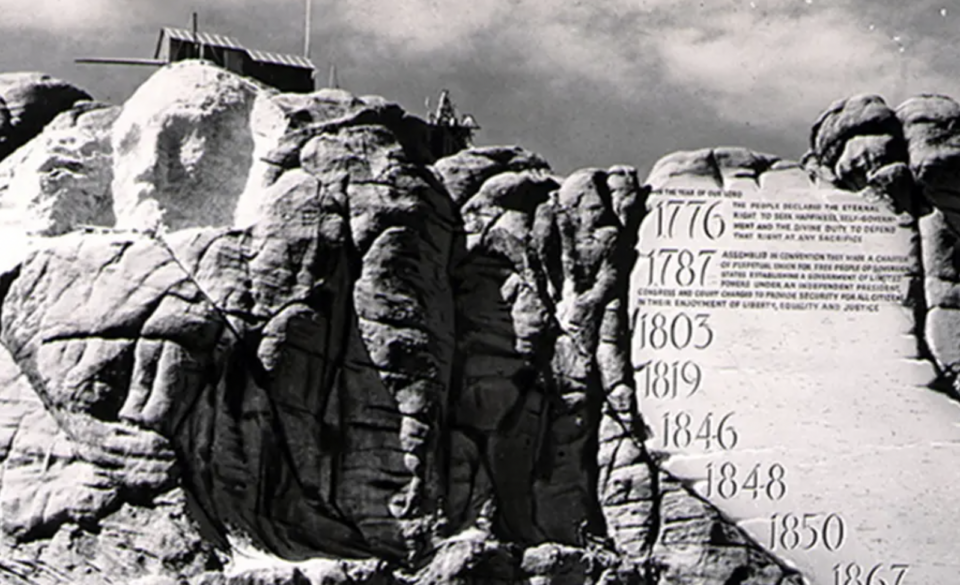On Halloween in 1941, the monumental project of carving the colossal profiles of four American presidents – George Washington, Thomas Jefferson, Abraham Lincoln, and Theodore Roosevelt – into the southeastern face of Mount Rushmore was finally accomplished. Yet, concealed from view behind Lincoln’s mighty brow is a lesser-known but crucial element of this Danish-American sculptor Gutzon Borglum’s “Shrine of Democracy Sculpture.”
Etched into the unyielding granite wall of a small canyon situated right behind the lineup of presidents lies an 18-foot-tall doorway reminiscent of the entrance to an ancient Egyptian pharaoh’s tomb. Those who step beyond the threshold would discover an empty room about 75 feet in length with a towering 35-foot-high ceiling. The walls, punctuated with holes meant for dynamite during the carving process, lend the chamber a honeycomb appearance. On these walls, red numbers, believed to be Borglum’s handiwork, offer guidance for rock removal.
Borglum had intended for this incomplete chamber to be his artistic statement elucidating the meaning of his sculpture. He conceived it as a message not for his contemporaries but for civilizations far in the future, including potential interplanetary visitors thousands of years hence. He was concerned that, over time, the carved faces on Mount Rushmore might become as enigmatic as Stonehenge. He stated, “Each succeeding civilization forgets its predecessor,” expressing his apprehension about the fleeting nature of human memory.
Originally, Borglum’s vision for Mount Rushmore included an 80-by-120-foot inscription beside Washington’s head, shaped like the Louisiana Purchase, listing nine pivotal events in U.S. history between 1776 and 1906. However, practicality and legibility concerns led to this part of the mountain being allocated for Lincoln’s visage. Borglum then devised plans for the “Hall of Records,” a grand chamber deep within the mountain intended to house America’s most cherished artifacts and documents, including the Declaration of Independence.
In this envisioned Hall of Records, Borglum planned for an 800-foot-long staircase ascending Mount Rushmore, leading to a magnificent chamber where the records of America’s aspirations and achievements would be preserved. The chamber’s walls would bear a literal record of the conception of the republic, its westward expansion, its presidents, and the construction of the memorial. Visitors would be greeted by massive glass doors, crowned by a bronze eagle with a 38-foot wingspan and the inscription “America’s Onward March.” The vaulted ceiling would feature a cross pointing to the North Star, while friezes on the walls would narrate “the adventure of humanity discovering and occupying the West World.” An inscription by John Edward Bradley would recount American history from its founding to the construction of the Panama Canal, while bronze and glass cabinets would safeguard documents such as the U.S. Constitution. The chamber would host busts of over 20 prominent Americans, encompassing Benjamin Franklin, John Hancock, Alexander Graham Bell, and the Wright Brothers.
However, despite a start on the construction in July 1938, work on the Hall of Records was halted just a year later due to funding constraints, with the federal government directing Borglum to complete the presidential profiles instead. After Gutzon Borglum’s passing in March 1941, his son Lincoln oversaw the finalization of the presidential carvings, marking the completion of the Mount Rushmore National Monument, yet leaving Borglum’s ultimate vision and the Hall of Records unfinished.
A partial realization of Borglum’s vision came to pass on August 9, 1998, when his family gathered in the incomplete chamber. Sixteen porcelain enamel panels, inscribed with the words of historical documents, biographies of the sculptor and the presidents, and accounts of the monument’s creation and U.S. history, were added. They were placed inside a teakwood box and a titanium vault, subsequently buried and sealed beneath a 1,200-pound black granite capstone inscribed with a Borglum quote from the 1930 dedication of Washington’s carving. However, the Hall of Records remains a part of Mount Rushmore largely hidden from view today due to safety and security concerns, barring visitors from scaling the mountain to witness this intriguing time capsule of American history.

